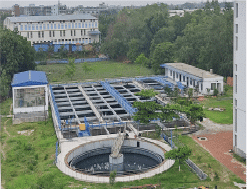Design, Fabrication & Maintenance
Industrial Experience
- Food and Beverage Industry
- Auto Rice Mills Industry
- Textile Washing Industry
- Municipal Sewage
- Sugar Refinery Industry
- Pharmaceuticals Industry
- Edible Oil Refinery Industry
- Textile Dying Industry
- Pulp and Paper Industry

Central Effluent Treatment Plant (CETP)
- Biological Treatment Plant
- Bio-Chemical Treatment Plant
- Chemical Treatment Plant
Central Sewage Treatment Plant (CSTP)


Central Water Treatment Plant (CWTP)

Reverse Osmosis (RO) Plant

Demineralization (DM) Water Treatment Plant
Drinking Water Treatment Plant (Industrial & Domestic)
The most common steps in water treatment used by Water Technology BD Ltd include:
Coagulation and Flocculation:
Coagulation and flocculation are often the first steps in water treatment. Chemicals with a positive charge are added to the water. The positive charge of these chemicals neutralizes the negative charge of dirt and other dissolved particles in the water. When this occurs, the particles bind with the chemicals and form larger particles, called floc.
Sedimentation:
During sedimentation, floc settles to the bottom of the water supply, due to its weight. This settling process is called sedimentation.
Filtration:
Once the floc has settled to the bottom of the water supply, the clear water on top will pass through filters of varying compositions (sand, gravel, and charcoal) and pore sizes, in order to remove dissolved particles, such as dust, parasites, bacteria, viruses, and chemicals.
Disinfection:
After the water has been filtered, a disinfectant (for example, chlorine, and chloramine) may be added in order to kill any remaining parasites, bacteria, and viruses, and to protect the water from germs when it is piped to homes and businesses
Zero Liquid Discharge Plant
Zero-liquid discharge (ZLD) is a water treatment process in which all wastewater is purified and recycled; therefore, leaving zero discharge at the end of the treatment cycle. Zero liquid discharge is an advanced wastewater treatment method that includes ultrafiltration, reverse osmosis, evaporation/crystallization, and fractional electrode ionization.
Water Technology BD Ltd (WTB) offers complete thermal and non-thermal ZLD solutions to manage tough-to-treat wastewater. WTBL’s proprietary evaporators, brine concentrators, and crystallizers can help recover more than 95% of your plant’s wastewater while reducing the remaining brine as a product or solid.
Zero Liquid Discharge Process
- Pretreatment and conditioning:
- Phase-one concentration
- Ultrafiltration (UF)
- Carbon Sand Filtration
- Ultrafiltration (UF)
- Membrane Bio-Reactor (MBR)
3R

